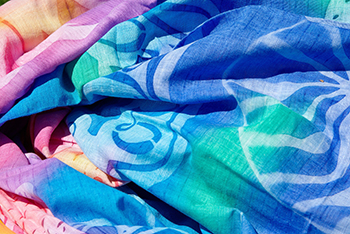 The way a t shirt looks and feels is probably the first thing we see when we look at it but how is this achieved. It is actually a chemical process that needs the fabric, large batches of fabric that can be 1000 kgs or more in weight to be scoured (washed), dyed (to impart colour) and finished (to impart softness). This then needs to be dried and part of this gives the fabric stability and reduces the shrinkage when it is washed at home.
The way a t shirt looks and feels is probably the first thing we see when we look at it but how is this achieved. It is actually a chemical process that needs the fabric, large batches of fabric that can be 1000 kgs or more in weight to be scoured (washed), dyed (to impart colour) and finished (to impart softness). This then needs to be dried and part of this gives the fabric stability and reduces the shrinkage when it is washed at home.
Scouring is the removal of naturally occurring waxes and mineral salts as well as added spinning and knitting lubricants from the surface of the fabric to allow the dyes to penetrate. The oils make the fabric hydrophobic (water hating) and the processor needs the fabric to be hydrophilic (water loving). This process is vitally important to make sure that the dyeing is done well. Another step that is carried out when the colour needs to be bright is bleaching. This used to involve chlorine based chemicals but should now only be done with hydrogen peroxide. So at the beginning of wet processing either a one step process or a two step process depending on the end result required. Between each stage the fabric needs to be properly washed off so there is not transfer of contaminants or chemicals. We should now have a hydrophilic fabric with an even base colour.
Recent improvements have been made with the use of enzymes to carry out this process at lower temperatures and using less harmful chemicals. The enzymes break down to harmless proteins and require much less processing in the effluent treatment plants.
Dyeing is the process of imparting colours. Traditionally for t shirts this is done using a machine called a jet which allows for circulation of the fabric and the liquor. Not that long ago the ration of the weight of water to the weight of fabric (the liquor ratio, LR) could be 20:1 but this has been brought down to LR5:1 or even lower saving large amounts of water. This also saves energy as the amount needed to heat up smaller amount of water is less. The dye makers have also produced dyes that have higher exhaustion rates (the amount of dye that transfers form the liquor to the fibre) meaning there is less waste and the wash off required (to remove loose dyes) is much lower. This again saves time, water and energy.
Finishing the fabric is both about improving the aesthetics of the fabric e.g. addition of softeners but also increasingly to provide added benefits. The relatively recent addition of using enzymes for bio polishing removes the loose fibres form the surface of the fabric and is dais to increase the lifetime of the garment therefore having the effect of reducing the number of purchases made.
A large part of good processing of fabrics is down to the knowledge of the substrate and the processes (the opposite is true that some of the horror stories told are where a lack of knowledge has caused over processing of fabrics with a detrimental effect on the environment) which means that education is key for the ongoing improvements in the wet processing of textiles.
These processes do use a lot of water but the industry is now using machines that use a lot less water and use dyes which fix to the fabric much better. This means that a t shirt dyed well uses less water at this stage then is probably used during its washing at home. Using good dyes means there is less wastage at the factory, less dye remaining in the water and less effluent that needs treatment. The colour stays on the fabric much better than before which means you can use the t shirt for much longer.
All this is positive for the environment and for sustainability if we all use less water and have to buy new clothes less often. With the large volumes of t shirt fabric need to clothe the world there will always be some dyers who cut corners and do things wrong. There will always be retailers who want to make such a margin that quality will be affected. It takes a lot of skill and knowledge at a high level to be able to dye a piece of fabric so it has less impact on the environment.

The Life Story of your T-shirt
This blog was written as part of an online event run by The Institute for Social Marketing as part of the Festival of Social Science week (7th-14th November 2015).
Visit our event hub to learn more about how t-shirts are made, make decisions about sustainability and share the story of your own favourite t-shirt.
Rate and Review
Rate this article
Review this article
Log into OpenLearn to leave reviews and join in the conversation.
Article reviews